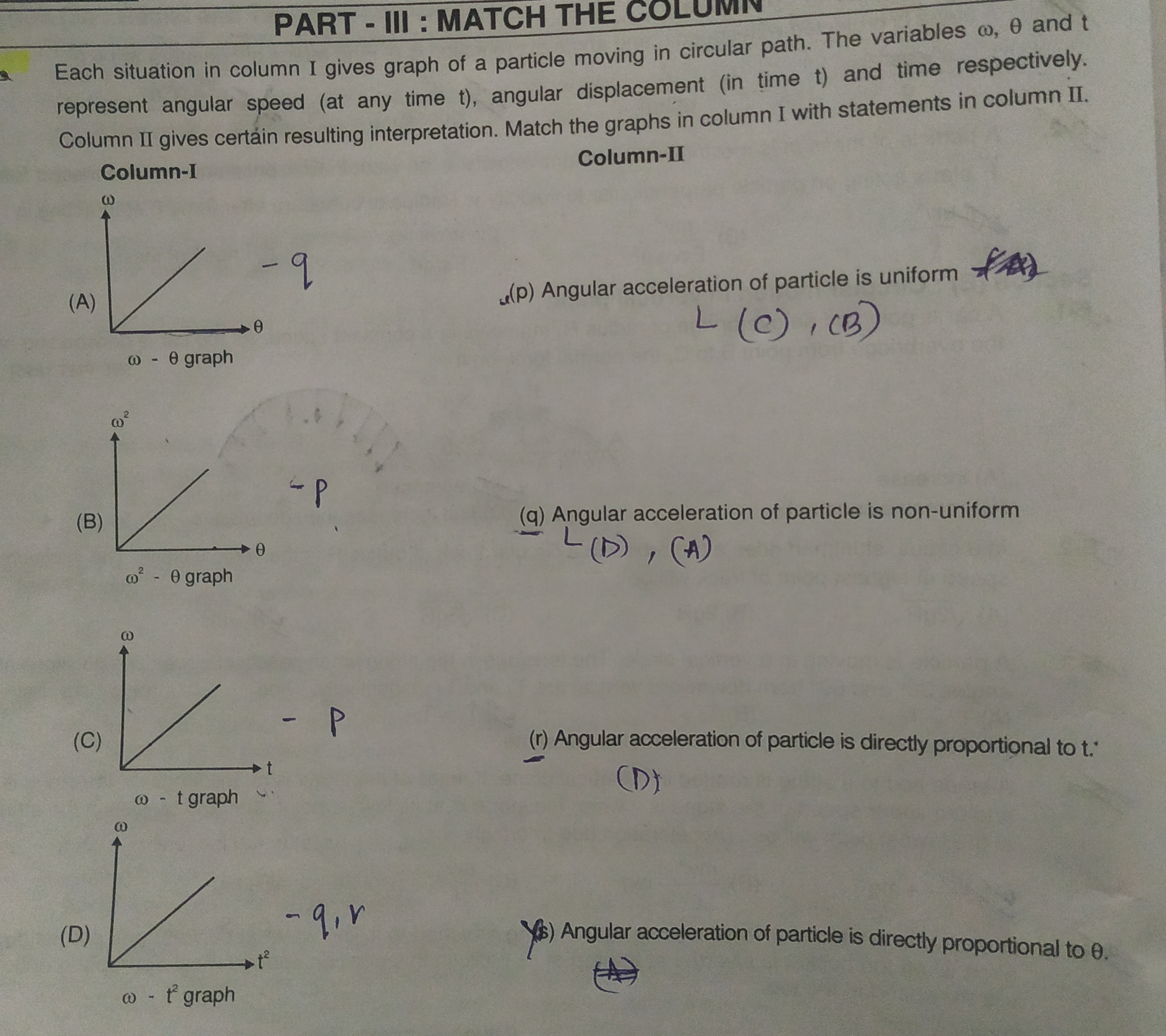Question
Question: Each situation in column I gives graph of a particle moving in circular path. The variables ω, θ and...
Each situation in column I gives graph of a particle moving in circular path. The variables ω, θ and t represent angular speed (at any time t), angular displacement (in time t) and time respectively. Column II gives certain resulting interpretation. Match the graphs in column I with statements in column II.
| Column-I | Column-II |
|---|---|
| (A) ω - θ graph | (p) Angular acceleration of particle is uniform |
| (B) ω² - θ graph | (q) Angular acceleration of particle is non-uniform |
| (C) ω - t graph | (r) Angular acceleration of particle is directly proportional to t. |
| (D) ω - t² graph | (s) Angular acceleration of particle is directly proportional to θ. |

A-(q,s)
B-(p)
C-(p)
D-(q,r)
A-(q,s), B-(p), C-(p), D-(q,r)
Solution
The problem requires matching graphs of angular motion variables with interpretations of angular acceleration. We will use the definitions of angular acceleration and kinematic equations for rotational motion.
Key Concepts:
-
Angular acceleration α=dtdω
-
Angular acceleration α=ωdθdω
-
For constant angular acceleration: ω=ω0+αt and ω2=ω02+2αθ
Analysis of each graph:
(A) ω−θ graph is a straight line passing through the origin.
This means ω∝θ, so we can write ω=kθ, where k is a constant. To find angular acceleration α, we use the relation α=ωdθdω. From ω=kθ, differentiating with respect to θ gives dθdω=k. Substituting these into the formula for α: α=(kθ)⋅k=k2θ.
-
Since α=k2θ, the angular acceleration is directly proportional to the angular displacement θ. This matches statement (s).
-
As α depends on θ (and is not constant), the angular acceleration is non-uniform. This matches statement (q).
Therefore, (A) matches with (q) and (s).
(B) ω2−θ graph is a straight line passing through the origin.
This means ω2∝θ, so we can write ω2=kθ, where k is a constant. We compare this with the kinematic equation for rotational motion: ω2=ω02+2αθ. Assuming the particle starts from rest (ω0=0), the equation becomes ω2=2αθ. Comparing ω2=kθ and ω2=2αθ, we find k=2α. This implies α=k/2. Since k is a constant, α is also a constant.
- Therefore, the angular acceleration of the particle is uniform. This matches statement (p).
Therefore, (B) matches with (p).
(C) ω−t graph is a straight line passing through the origin.
This means ω∝t, so we can write ω=kt, where k is a constant. To find angular acceleration α, we use the definition α=dtdω. From ω=kt, differentiating with respect to t gives dtdω=k. So, α=k. Since k is a constant, α is also a constant.
- Therefore, the angular acceleration of the particle is uniform. This matches statement (p).
Therefore, (C) matches with (p).
(D) ω−t2 graph is a straight line passing through the origin.
This means ω∝t2, so we can write ω=kt2, where k is a constant. To find angular acceleration α, we use the definition α=dtdω. From ω=kt2, differentiating with respect to t gives dtdω=2kt. So, α=2kt.
-
Since α=2kt, the angular acceleration is directly proportional to time t. This matches statement (r).
-
As α depends on t (and is not constant), the angular acceleration is non-uniform. This matches statement (q).
Therefore, (D) matches with (q) and (r).
Final Matches:
-
(A) matches with (q), (s)
-
(B) matches with (p)
-
(C) matches with (p)
-
(D) matches with (q), (r)
